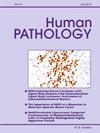胃淋巴组织增生分类线索的跨学科分析:外科病理学家的作用。
IF 2.6
2区 医学
Q2 PATHOLOGY
引用次数: 0
摘要
检查胃活检的外科病理学家必须为血液病理学会诊分诊旺盛的淋巴浸润,这项任务应该考虑到资源和时间的利用。我们收集了所有的慢性胃炎病例,由外科病理学家送到血液病理学,因为担心低级别淋巴瘤超过4年的间隔。这些病例最终被分类为反应性(n=37)、非典型(n=9)或淋巴瘤(n=18)。外科病理学家评估淋巴细胞聚集物的分布和密度、淋巴上皮病变的存在、原生结构的破坏、单核细胞和/或着丝细胞和/或高级别细胞学。内镜检查结果、幽门螺杆菌感染和淋巴瘤病史均有记录。大多数反应性浸润仅表现出上述一种特征,而非典型病例往往至少有两种,淋巴瘤至少有3种淋巴瘤的组织学特征。Logistic回归分析显示,淋巴瘤病史和组织学特征>3的存在与最终的非典型或淋巴瘤分类有显著相关性。全层淋巴浸润的存在具有重要意义。这三个特征的结合产生了受试者工作特征(ROC)曲线下的面积为0.9,表明反应性和非典型淋巴浸润/淋巴瘤之间有很好的区分。我们的结论是,外科病理学家可以通过结合临床资料和组织学特征评估可靠地分诊胃淋巴浸润以进行会诊和辅助研究。本文章由计算机程序翻译,如有差异,请以英文原文为准。
Interdisciplinary analysis of cues to triage gastric lymphoid proliferations: Role of the surgical pathologist revisited
Surgical pathologists who examine gastric biopsies must triage exuberant lymphoid infiltrates for hematopathology consultation, a task that should account for resource and time utilization. We assembled all cases of chronic gastritis sent by surgical pathologists to hematopathology due to concern for low-grade lymphoma over a 4-year interval. The cases were ultimately classified as reactive (n = 37), atypical (n = 9), or lymphoma (n = 18). A surgical pathologist assessed lymphoid aggregates for their distribution and density, the presence of lymphoepithelial lesions, destruction of native structures, and monocytoid and/or centrocytoid and/or high grade cytology. Endoscopic findings, Helicobacter pylori infection, and any history of lymphoma were documented. Most reactive infiltrates displayed only one of the aforementioned concerning features, whereas atypical cases tended to have at least two and lymphomas at least 3 histologic hallmarks of lymphoma. Logistic regression analysis showed that history of lymphoma, and presence of >3 concerning histologic features were significantly associated with final classification of atypical or lymphoma. The presence of full thickness lymphoid infiltrates approached significance. Combination of these three features produced an area under a receiver operating characteristic (ROC) curve of 0.9, indicating excellent discrimination between reactive and atypical lymphoid infiltrates/lymphomas. We conclude that surgical pathologists can reliably triage gastric lymphoid infiltrates for consultation and ancillary studies by combining clinical data with evaluation of histologic features.
求助全文
通过发布文献求助,成功后即可免费获取论文全文。
去求助
来源期刊

Human pathology
医学-病理学
CiteScore
5.30
自引率
6.10%
发文量
206
审稿时长
21 days
期刊介绍:
Human Pathology is designed to bring information of clinicopathologic significance to human disease to the laboratory and clinical physician. It presents information drawn from morphologic and clinical laboratory studies with direct relevance to the understanding of human diseases. Papers published concern morphologic and clinicopathologic observations, reviews of diseases, analyses of problems in pathology, significant collections of case material and advances in concepts or techniques of value in the analysis and diagnosis of disease. Theoretical and experimental pathology and molecular biology pertinent to human disease are included. This critical journal is well illustrated with exceptional reproductions of photomicrographs and microscopic anatomy.
 求助内容:
求助内容: 应助结果提醒方式:
应助结果提醒方式:


